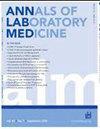神经退行性疾病、创伤性脑损伤和中枢神经系统肿瘤循环生物标志物研究进展
IF 3.9
2区 医学
Q1 MEDICAL LABORATORY TECHNOLOGY
引用次数: 0
摘要
神经系统疾病,包括神经退行性疾病、创伤性脑损伤(TBI)和中枢神经系统(CNS)肿瘤,是严重影响全球患者的复杂疾病。及时诊断和监测对于改善结果至关重要,这推动了对可靠生物标志物的需求。具体来说,在脑脊液(CSF)和血液中检测到的生物标志物为疾病的存在和进展提供了重要的见解。本文综述了循环血液生物标志物在神经退行性疾病、TBI和中枢神经系统肿瘤中的发展,重点介绍了从酶联免疫吸附测定(elisa)到电化学发光(ECL)测定、单分子阵列(Simoa)和质谱分析等先进检测技术。先进的技术具有更高的灵敏度和特异性,特别是在检测低丰度分析物方面,有助于研究各种神经系统疾病的脑脊液生物标志物。我们还描述了基于血液的生物标志物的进展,作为脑脊液取样的侵入性较小的替代品。临床上,阿尔茨海默病(AD)血液生物标志物Aβ42/Aβ40比值和载脂蛋白E亚型特异性肽可以帮助诊断,而p-tau181和p-tau217可以区分AD痴呆与非AD神经退行性疾病。血液胶质纤维酸性蛋白和泛素c端水解酶- l1用于排除轻度TBI。尽管有这些创新,挑战仍然存在,包括分析标准化,敏感性/特异性权衡,以及纵向研究的要求,以了解生物标志物随时间的效用。未来的研究应集中于解决这些挑战,以充分发挥血液生物标志物在神经疾病诊断和患者护理中的潜力。本文章由计算机程序翻译,如有差异,请以英文原文为准。
Advances in Circulating Biomarkers for Neurodegenerative Diseases, Traumatic Brain Injuries, and Central Nervous System Tumors.
Neurological disorders, including neurodegenerative diseases, traumatic brain injuries (TBI), and central nervous system (CNS) tumors, are complex conditions that significantly impact patients globally. Timely diagnosis and monitoring are critical for improving outcomes, driving the need for reliable biomarkers. Specifically, biomarkers detectable in cerebrospinal fluid (CSF) and blood offer important insights into disease presence and progression. This review explores the evolution of circulating blood biomarkers for neurodegenerative diseases, TBI, and CNS tumors, highlighting advanced detection technologies from enzyme-linked immunosorbent assays (ELISAs) to electrochemiluminescence (ECL) assays, single-molecule arrays (Simoa), and mass spectrometry. Advanced technologies with enhanced sensitivity and specificity, particularly in detecting low-abundance analytes, facilitate the investigation of CSF biomarkers for various neurological disorders. We also describe the progress in blood-based biomarkers for , emerging as less invasive alternatives to CSF sampling. Clinically, the implementation of Alzheimer's disease (AD) blood biomarkers Aβ42/Aβ40 ratio and Apolipoprotein E isoform-specific peptide can aid the diagnosis, while p-tau181 and p-tau217 differentiates AD dementia from non-AD neurodegenerative diseases. Blood glial fibrillary acidic protein and ubiquitin C-terminal hydrolase-L1 are used in ruling out mild TBI. Despite these innovations, challenges remain, including assay standardization, sensitivity/specificity trade-offs, and the requirement for longitudinal studies to understand biomarker utility over time. Future research should focus on addressing these challenges to fully realize the potential of blood-based biomarkers in neurological disorder diagnostics and patient care.
求助全文
通过发布文献求助,成功后即可免费获取论文全文。
去求助
来源期刊

Annals of Laboratory Medicine
MEDICAL LABORATORY TECHNOLOGY-
CiteScore
8.30
自引率
12.20%
发文量
100
审稿时长
6-12 weeks
期刊介绍:
Annals of Laboratory Medicine is the official journal of Korean Society for Laboratory Medicine. The journal title has been recently changed from the Korean Journal of Laboratory Medicine (ISSN, 1598-6535) from the January issue of 2012. The JCR 2017 Impact factor of Ann Lab Med was 1.916.
 求助内容:
求助内容: 应助结果提醒方式:
应助结果提醒方式:


